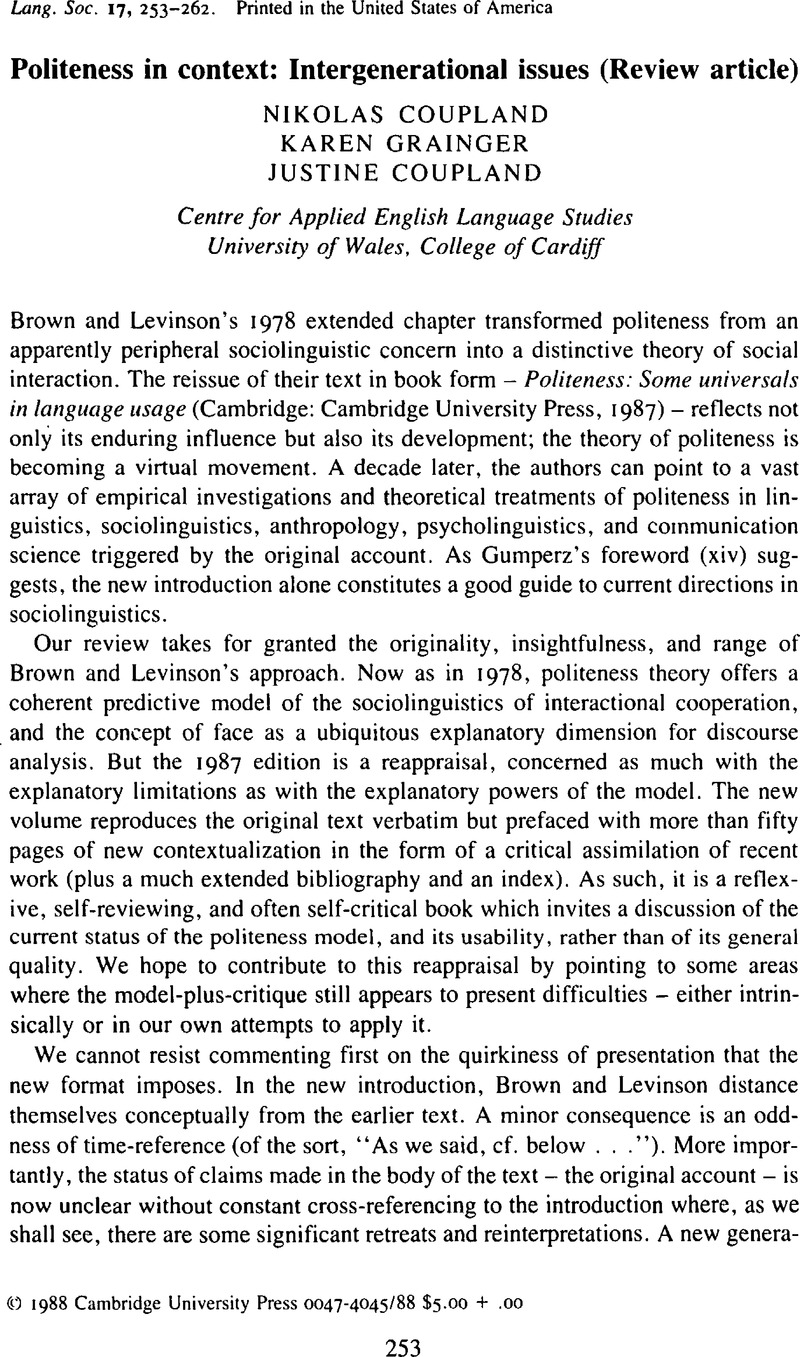Crossref Citations
This article has been cited by the following publications. This list is generated based on data provided by Crossref.
Kemper, Susan
and
Anagnopoulos, Cheryl
1989.
Language and Aging.
Annual Review of Applied Linguistics,
Vol. 10,
Issue. ,
p.
37.
Aronsson, Karin
and
Rundström, Bengt
1989.
Cats, dogs, and sweets in the clinical negotiation of reality: On politeness and coherence in pediatric discourse.
Language in Society,
Vol. 18,
Issue. 4,
p.
483.
Penman, Robyn
1990.
Facework & Politeness: Multiple Goals in Courtroom Discourse.
Journal of Language and Social Psychology,
Vol. 9,
Issue. 1-2,
p.
15.
Wilson, Steven R.
Kim, Min‐Sun
and
Meischke, Hendrika
1991.
Evaluating Brown and Levinson's politeness theory: A revised analysis of directives and face.
Research on Language & Social Interaction,
Vol. 25,
Issue. 1-4,
p.
215.
Wood, Linda A.
and
Ryan, Ellen Bouchard
1991.
Talk to Elders: Social Structure, Attitudes and Forms of Address.
Ageing and Society,
Vol. 11,
Issue. 2,
p.
167.
Tsitsipis, Lukas D.
1991.
Terminal-fluent speaker interaction and the contextualization of deviant speech.
Journal of Pragmatics,
Vol. 15,
Issue. 2,
p.
153.
KACHRU, YAMUNA
1991.
SYMPOSIUM ON SPEECH ACTS IN WORLD ENGLISHES.
World Englishes,
Vol. 10,
Issue. 3,
p.
295.
Ferguson, Alison
1992.
Interpersonal aspects of aphasic conversation.
Journal of Neurolinguistics,
Vol. 7,
Issue. 4,
p.
277.
GOLDSMITH, DAENA
1992.
Managing Conflicting Goals in Supportive Interaction.
Communication Research,
Vol. 19,
Issue. 2,
p.
264.
Bogoch, Bryna
1994.
Power, Distance and Solidarity: Models of Professional-Client Interaction in an Israeli Legal Aid Setting.
Discourse & Society,
Vol. 5,
Issue. 1,
p.
65.
Mao, LuMing Robert
1994.
Beyond politeness theory: ‘Face’ revisited and renewed.
Journal of Pragmatics,
Vol. 21,
Issue. 5,
p.
451.
Kemper, Susan
1994.
Elderspeak: Speech accommodations to older adults.
Aging, Neuropsychology, and Cognition,
Vol. 1,
Issue. 1,
p.
17.
Kemper, Susan
Lyons, Kelly
and
Anagnopoulos, Cheryl
1995.
Joint storytelling by patients with Alzheimer's disease and their spouses.
Discourse Processes,
Vol. 20,
Issue. 2,
p.
205.
Meier, A.J.
1995.
Defining politeness: Universality in appropriateness.
Language Sciences,
Vol. 17,
Issue. 4,
p.
345.
Turner, Ken
1996.
The principal principles of pragmatic inference: politeness.
Language Teaching,
Vol. 29,
Issue. 1,
p.
1.
Kemper, Susan
Othick, Meghan
Warren, Jennifer
Gubarchuk, Julia
and
Gerhing, Hope
1996.
Facilitating older adults' performance on a referential communication task through speech accommodations.
Aging, Neuropsychology, and Cognition,
Vol. 3,
Issue. 1,
p.
37.
Bowie, Iain
1996.
Terms of address: implications for nursing.
Journal of Advanced Nursing,
Vol. 23,
Issue. 1,
p.
113.
Buck, R.A.
1997.
Towards an extended theory of face action: Analyzing dialogue in E.M. Forster's A Passage to India.
Journal of Pragmatics,
Vol. 27,
Issue. 1,
p.
83.
Pilegaard, Morten
1997.
Politeness in written business discourse: A textlinguistic perspective on requests.
Journal of Pragmatics,
Vol. 28,
Issue. 2,
p.
223.
Dillard, James Price
Wilson, Steven R.
Tusing, Kyle James
and
Kinney, Terry A.
1997.
Politeness Judgments in Personal Relationships.
Journal of Language and Social Psychology,
Vol. 16,
Issue. 3,
p.
297.



